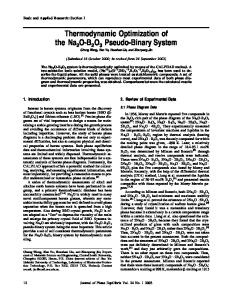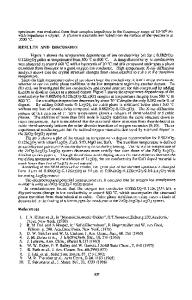Critical thermodynamic evaluation and optimization of the FeO-Fe 2 O 3 -MgO-SiO 2 system
- PDF / 556,549 Bytes
- 13 Pages / 612 x 792 pts (letter) Page_size
- 17 Downloads / 366 Views
I. INTRODUCTION
THE FeO-Fe2O3-MgO-SiO2 system is important for many industries and processes. This system is a key system in the corrosion of magnesite refractories by iron oxide in steelmaking processes and is also a fundamental system in pyrometallurgical processes. Magnesium ferrite spinel has interesting magnetic properties, and solid-solution phases such as magnesiowustite, olivine, and pyroxenes are of primary importance in understanding the Earth’s mantle. Experimental study of this system is complicated by the strong dependence of phase equilibria on oxygen partial pressure. Therefore, critical assessment of experimental data and thermodynamic optimization is required in order to understand and model this system more accurately. Fabrichnaya[1] roughly modeled the solidus and liquidus data in this system. Wu et al.[2] optimized the FeO-MgO-SiO2 system at metallic iron saturation. However, complete optimization of this quaternary system has not yet been performed. Optimizations of the binary and ternary subsystems Fe-O, MgO-SiO2, FeO-Fe2O3-MgO, and FeO-Fe2O3-SiO2 were reported earlier.[2,3,4] The calculated phase diagrams of the MgOSiO2 and FeO-Fe2O3-SiO2 systems at iron saturation and in air are given in Figures 1 through 3. The main goal of the present study is to perform a complete review, critical assessment, and optimization of thermodynamic properties at 1 bar total pressure of oxide phases in the FeO-Fe2O3-MgO-SiO2 (Fe-Mg-Si-O) system. In the thermodynamic “optimization” of a system, all available thermoIN-HO JUNG, Senior Researcher, is with the New Metals Research Team, Research Institute of Industrial Science & Technology (RIST), Pohang, South Korea 790-600. SERGEI A. DECTEROV, Research Professor, and ARTHUR D. PELTON, Full Professor, are with the Centre de Recherche en Calcul Thermochimique (CRCT), École Polytechnique de Montréal, Montréal, PQ, Canada H3C 3A7. Contact e-mail: apelton@ polymtl.ca Manuscript submitted November 11, 2003. METALLURGICAL AND MATERIALS TRANSACTIONS B
dynamic and phase-equilibrium data are evaluated simultaneously in order to obtain one set of model equations for the Gibbs energies of all phases as functions of temperature and composition. From these equations, all of the thermodynamic properties and the phase diagrams can be backcalculated. In this way, all the data are rendered self-consistent and consistent with thermodynamic principles. Thermodynamic property data such as activity data, can aid in the evaluation of the phase diagram, and phase-diagram measurements can be used to deduce thermodynamic properties. Discrepancies in the available data can often be resolved, and interpolations and extrapolations can be made in a thermodynamically correct manner. The resultant model database provides the best presently available description of the thermodynamic properties and phase equilibria. Software tools exist which permit the evaluator to enter experimental data points as input and obtain as output a set of model parameters which satisfy some criterion such as a minimum
Data Loading...











